MASI Lugano is the perfect base to explore the culture, architecture
& landscapes of Switzerland
Spread across three buildings in Lugano, Switzerland,
including two huge galleries in a cultural centre designed by Ivano Gioanola, MASI
Lugano is the perfect base from which to explore the landscapes &
architecture of the Ticino region. A walkable city & landscape set against
the Lake Lugano & with a rich architectural history including a number of
Mario Botta buildings, Lugano is also perfect for a refreshing cultural getaway.
Will Jennings visited exhibitions of work by Alexander Calder, Luigi Ghirri,
Arman & Yves Klein, amongst much more in the city.
ARRIVING IN LUGANO
The arrival into Lugano on the train from Milan is increasingly poetic. As train tracks lead from the industrial suburbs towards the Swiss border, a gravitational pull from the alps that gets stronger as the mountains increase in scale, the vistas become increasingly pastoral before opening up onto lake views. The view across Lake Lugano is enticing, mountain peaks layering into the distance, a gradient of hues reflected from the still waters, a natural calmness overlooked by sporadic moments of architecture clambering up the sides.
Across the other side of the lake, one giant building can be seen clearly above the otherwise small municipality of Campione d’Italia, a small island of Italy in the Swiss landscape. The Casinò di Campione was designed by Swiss architect Mario Botta, the largest of many buildings across this region, including a few in the city of Lugano. Botta is the most celebrated designer from the Ticino architecture movement, a modern vernacular created from this region of Switzerland specifically for its robust landscape.
The arrival into Lugano on the train from Milan is increasingly poetic. As train tracks lead from the industrial suburbs towards the Swiss border, a gravitational pull from the alps that gets stronger as the mountains increase in scale, the vistas become increasingly pastoral before opening up onto lake views. The view across Lake Lugano is enticing, mountain peaks layering into the distance, a gradient of hues reflected from the still waters, a natural calmness overlooked by sporadic moments of architecture clambering up the sides.
Across the other side of the lake, one giant building can be seen clearly above the otherwise small municipality of Campione d’Italia, a small island of Italy in the Swiss landscape. The Casinò di Campione was designed by Swiss architect Mario Botta, the largest of many buildings across this region, including a few in the city of Lugano. Botta is the most celebrated designer from the Ticino architecture movement, a modern vernacular created from this region of Switzerland specifically for its robust landscape.



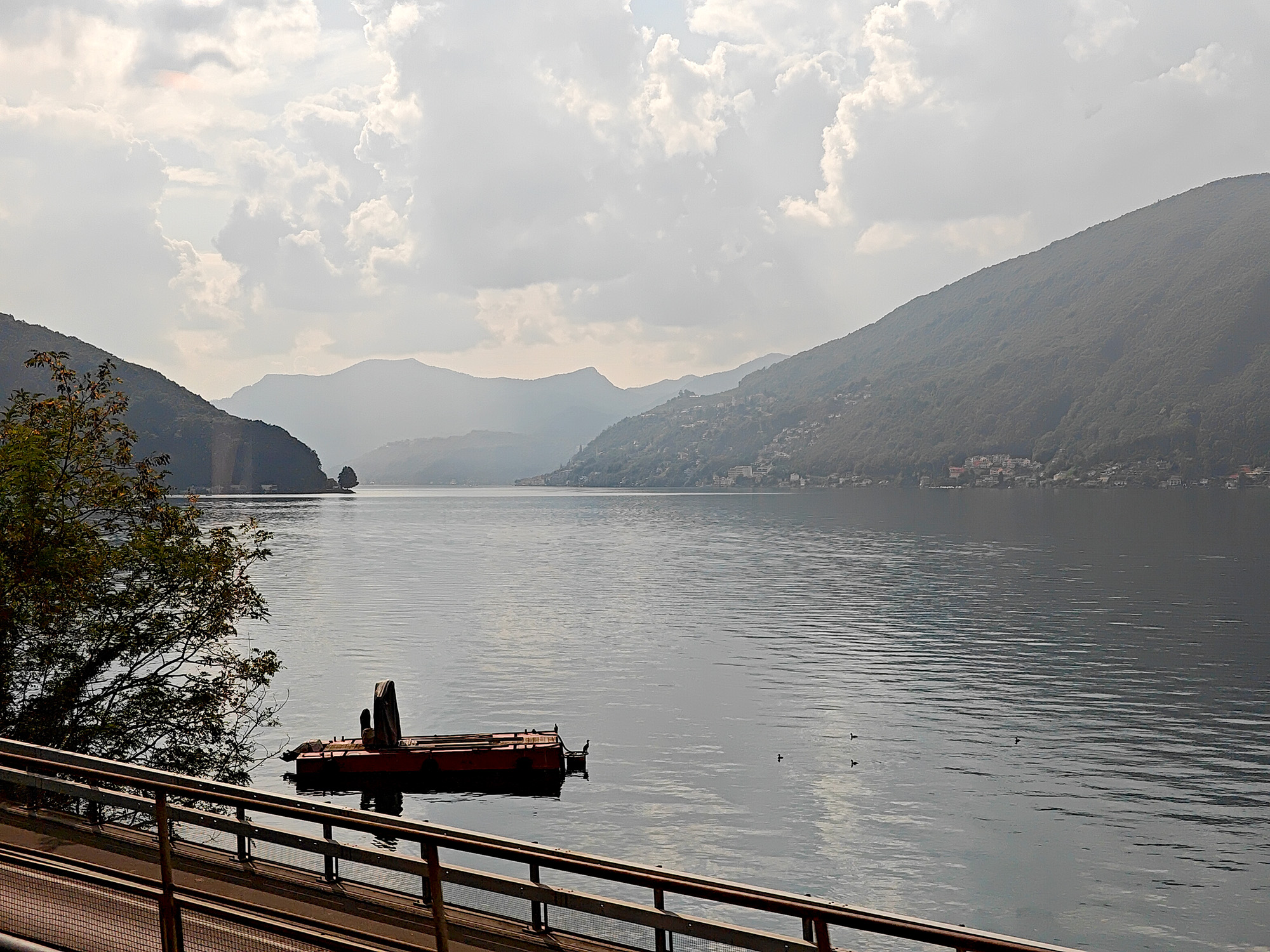



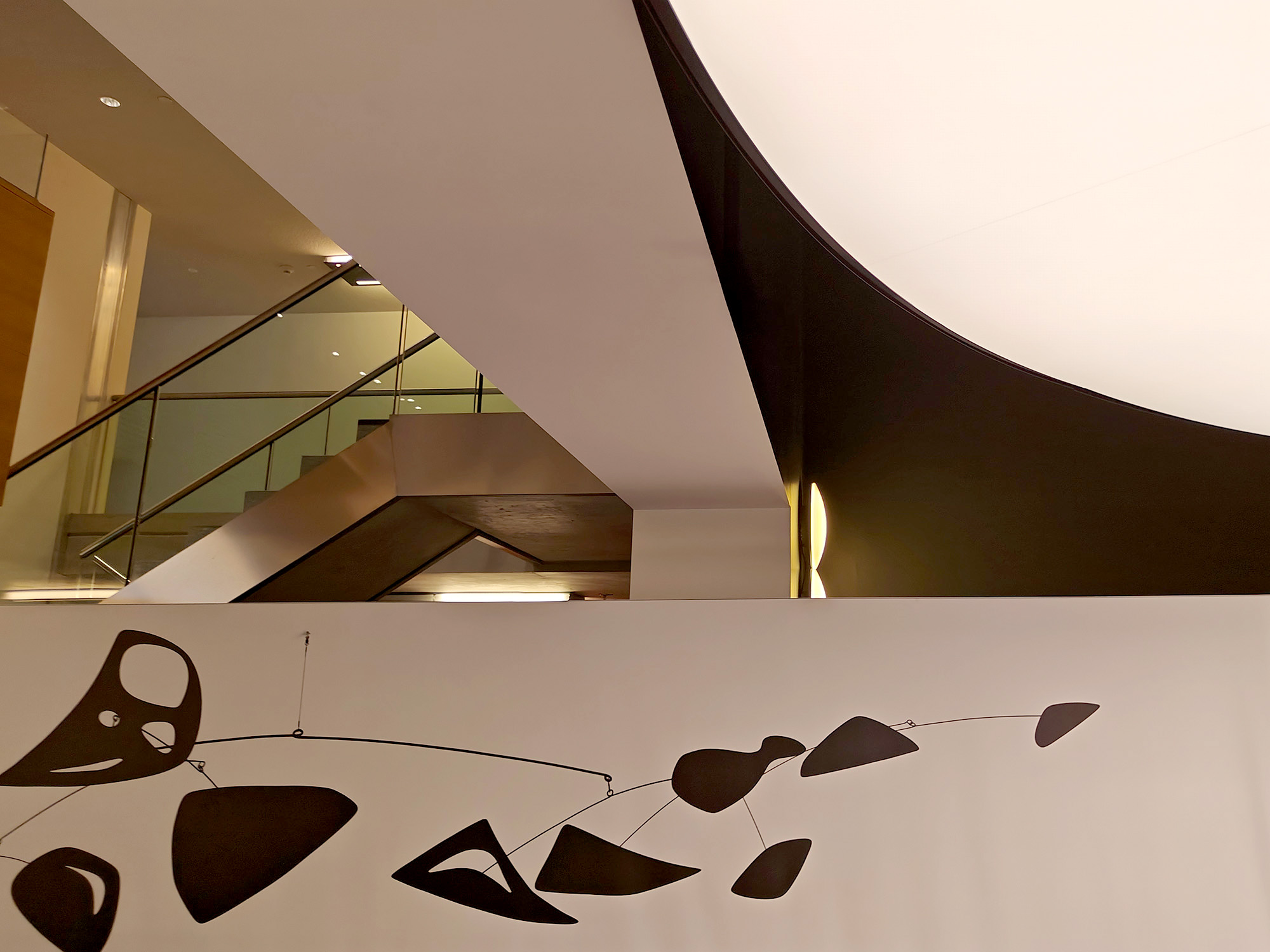
MASI LUGANO
recessed.space travelled to Lugano to see the city’s main cultural institution, Museo d’arte della Svizzera italiana – known as MASI Lugano. Ten years old next year, the organisation is housed in a huge cultural complex designed by Ticino architect Ivano Gianola, his building housing a concert and theatre hall, restaurant, and shop, alongside large exhibition spaces cantilevered towards the lake over a public plaza.
We had visited before. Back in late-2023, Robert Barry interviewed artist Thomas Huber on the occasion of his “homecoming” exhibition (00148) considering at Swiss mountains and how light plays with the lake’s surface – the deepest point of each main gallery offers framed views across Lake Lugano, offering a postcard-view onto the very landscapes that inspired Huber.
MASI not only has their two main galleries, but also a space for their historic collection in the city-centre Palazzo Reali, as well as a collaboration with the The Collezione Giancarlo e Danna Olgiati in a subterranean gallery adjacent to their Gioanola-designed home.
recessed.space travelled to Lugano to see the city’s main cultural institution, Museo d’arte della Svizzera italiana – known as MASI Lugano. Ten years old next year, the organisation is housed in a huge cultural complex designed by Ticino architect Ivano Gianola, his building housing a concert and theatre hall, restaurant, and shop, alongside large exhibition spaces cantilevered towards the lake over a public plaza.
We had visited before. Back in late-2023, Robert Barry interviewed artist Thomas Huber on the occasion of his “homecoming” exhibition (00148) considering at Swiss mountains and how light plays with the lake’s surface – the deepest point of each main gallery offers framed views across Lake Lugano, offering a postcard-view onto the very landscapes that inspired Huber.
MASI not only has their two main galleries, but also a space for their historic collection in the city-centre Palazzo Reali, as well as a collaboration with the The Collezione Giancarlo e Danna Olgiati in a subterranean gallery adjacent to their Gioanola-designed home.
LUIGI GHIRRI AT MASI LUGANO
MASI’s current main exhibition is Viaggi, a major presentation of Italian photographer Luigi Ghirri who not only pushed the whole genre of photography into a playful but non-patronising realm of everyday photojournalism but who also presented a singular and critical view upon landscape and the built environment. This presentation is curated by James Lingwood, co-director of Artangel from 1991 until 2022, and is a rich selection of the artist’s work organised thematically.
The presentation, as is often the case with traditional photographic hangs, is dry. White wall after white wall of identically-framed, identically presented prints, all hung uniformly at the same height with the same spacing, it is a curation that could turn the average visitor off photography as an artform. But the magic of Ghirri isn’t hard to find underneath the prosaic hang, his voice and eye is present throughout this rich selection and lifts the exhibition with wit and a unique vantage upon the world. It is just a shame that the presentation doesn’t have the same joy or originality.
MASI’s current main exhibition is Viaggi, a major presentation of Italian photographer Luigi Ghirri who not only pushed the whole genre of photography into a playful but non-patronising realm of everyday photojournalism but who also presented a singular and critical view upon landscape and the built environment. This presentation is curated by James Lingwood, co-director of Artangel from 1991 until 2022, and is a rich selection of the artist’s work organised thematically.
The presentation, as is often the case with traditional photographic hangs, is dry. White wall after white wall of identically-framed, identically presented prints, all hung uniformly at the same height with the same spacing, it is a curation that could turn the average visitor off photography as an artform. But the magic of Ghirri isn’t hard to find underneath the prosaic hang, his voice and eye is present throughout this rich selection and lifts the exhibition with wit and a unique vantage upon the world. It is just a shame that the presentation doesn’t have the same joy or originality.













There are repeat motifs throughout Ghirri’s work: Mountains;
mass-tourism; simulacra; ideas of territory; the everyday; and ephemera.
Lingwood loosely connects these themes, but the visitor can find countless more
of their own making across Ghirri’s wide output – the way the photographer
frames, crops, captures people from behind, the use of shade, the obtuse angle.
These are all photographic characteristics that we see in a whole genre of work today, and which for example Martin Parr has heavily leaned into. But where many are critical around Parr’s reading of class, subjectivity, and agency in his images, Ghirri’s work presents a joyful and non-judgemental rendering of place, people, and subject.
Ghirri passed away in Reggio Emilia in 1992, aged only 49, his work fittingly frozen in that early-90s framing of simulation, hyperreality, and historicity that Jean Baudrillard wrote about so richly and still impacts how the world is made and seen today – indeed, a whole section curated by Lingwood considers Ghirri’s use of maps and territory with an extremely Baudrillardian vantage.
After leaving MASI and entering Lugano, having been so subsumed in the landscapes and places presented in Viaggi, it becomes hard to see normally again, and every travel photograph taken after seems to carry with it a sense of Ghirri’s way of reading the world.
These are all photographic characteristics that we see in a whole genre of work today, and which for example Martin Parr has heavily leaned into. But where many are critical around Parr’s reading of class, subjectivity, and agency in his images, Ghirri’s work presents a joyful and non-judgemental rendering of place, people, and subject.
Ghirri passed away in Reggio Emilia in 1992, aged only 49, his work fittingly frozen in that early-90s framing of simulation, hyperreality, and historicity that Jean Baudrillard wrote about so richly and still impacts how the world is made and seen today – indeed, a whole section curated by Lingwood considers Ghirri’s use of maps and territory with an extremely Baudrillardian vantage.
After leaving MASI and entering Lugano, having been so subsumed in the landscapes and places presented in Viaggi, it becomes hard to see normally again, and every travel photograph taken after seems to carry with it a sense of Ghirri’s way of reading the world.
WALKING LUGANO
Lugano is largely water. While the town clambers up the hill with a mix of historic and contemporary vernaculars, it all overlooks and is shaped around Lake Lugano. The views onto the lake, as so considered by Thomas Huber, flirt with the open skies above, with subtle shifts in light quality to offer a deeply romantic but changing hue from dawn to dusk. Mountains dominate the distance, but their reflections lead to the foreground.
The path becomes a promenade, busy in the city centre but leading beyond, wrapping the water’s edge to smaller, once-remote villages. Gandria is such a village, steeply clinging the steep side of the lake and inaccessible by car, it can be reached via the pleasant undulations of the Olive Path, passing plantations of olive trees with constantly changing views across Lake Lugano.
Lugano is largely water. While the town clambers up the hill with a mix of historic and contemporary vernaculars, it all overlooks and is shaped around Lake Lugano. The views onto the lake, as so considered by Thomas Huber, flirt with the open skies above, with subtle shifts in light quality to offer a deeply romantic but changing hue from dawn to dusk. Mountains dominate the distance, but their reflections lead to the foreground.
The path becomes a promenade, busy in the city centre but leading beyond, wrapping the water’s edge to smaller, once-remote villages. Gandria is such a village, steeply clinging the steep side of the lake and inaccessible by car, it can be reached via the pleasant undulations of the Olive Path, passing plantations of olive trees with constantly changing views across Lake Lugano.







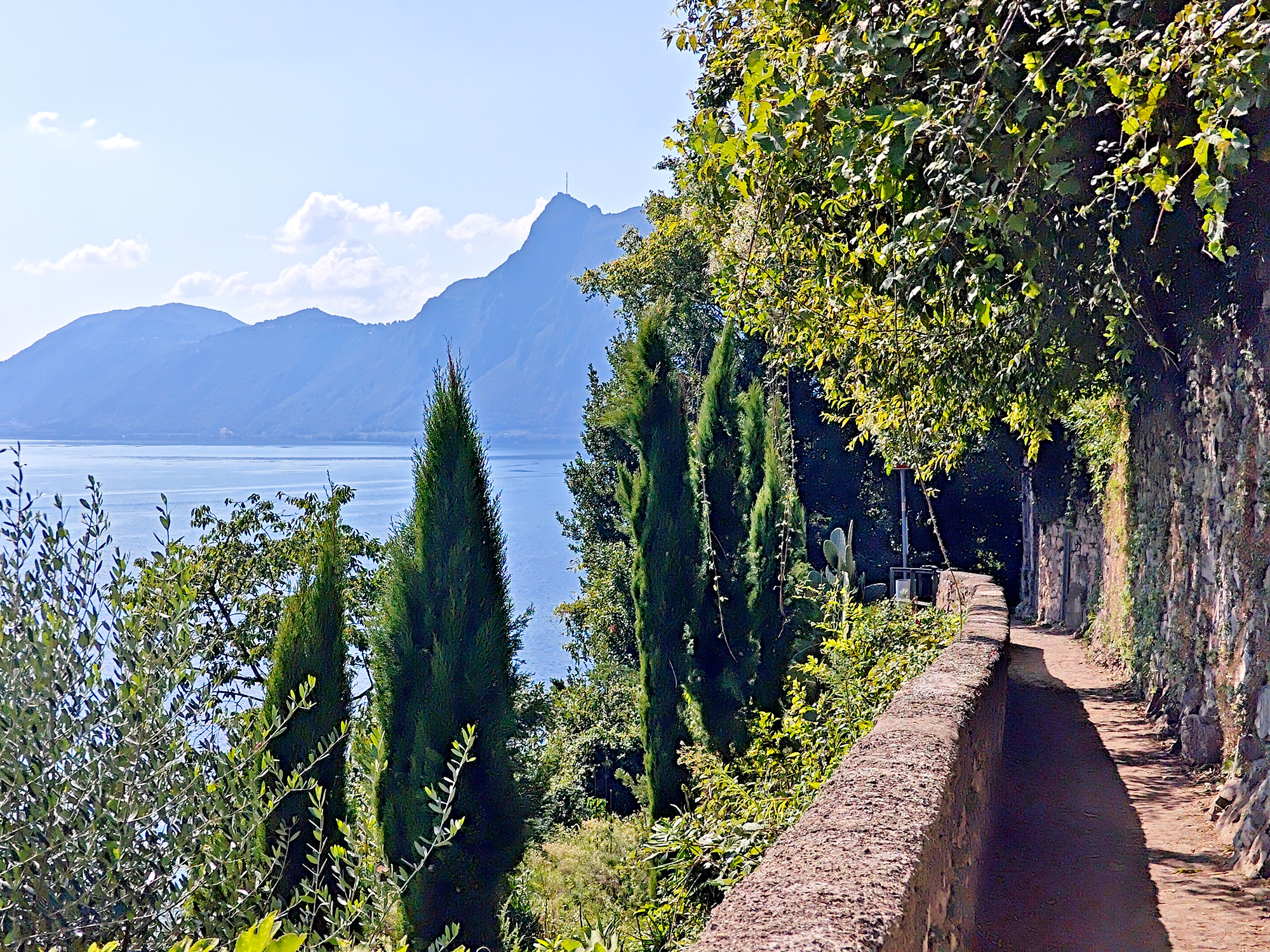




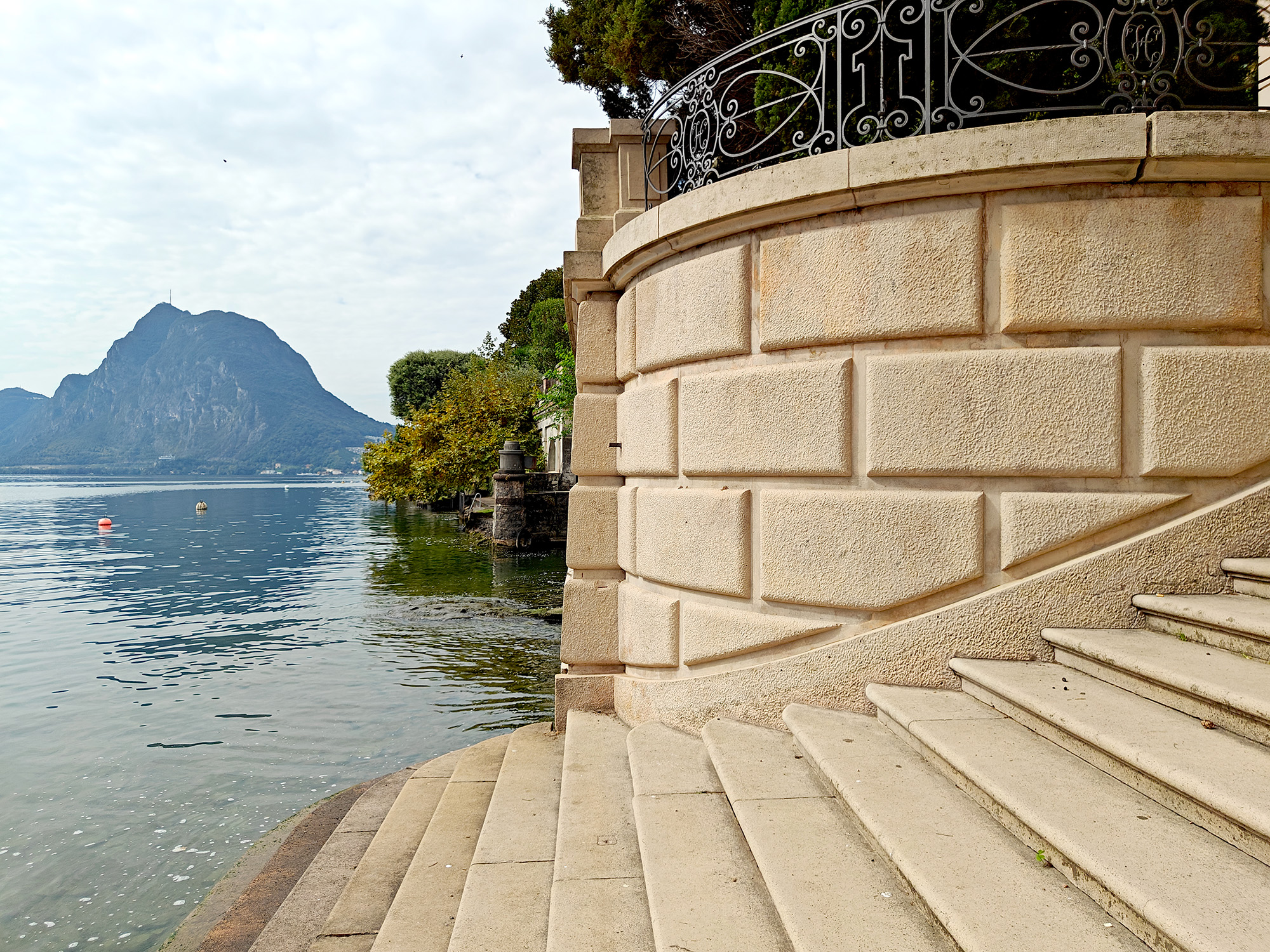



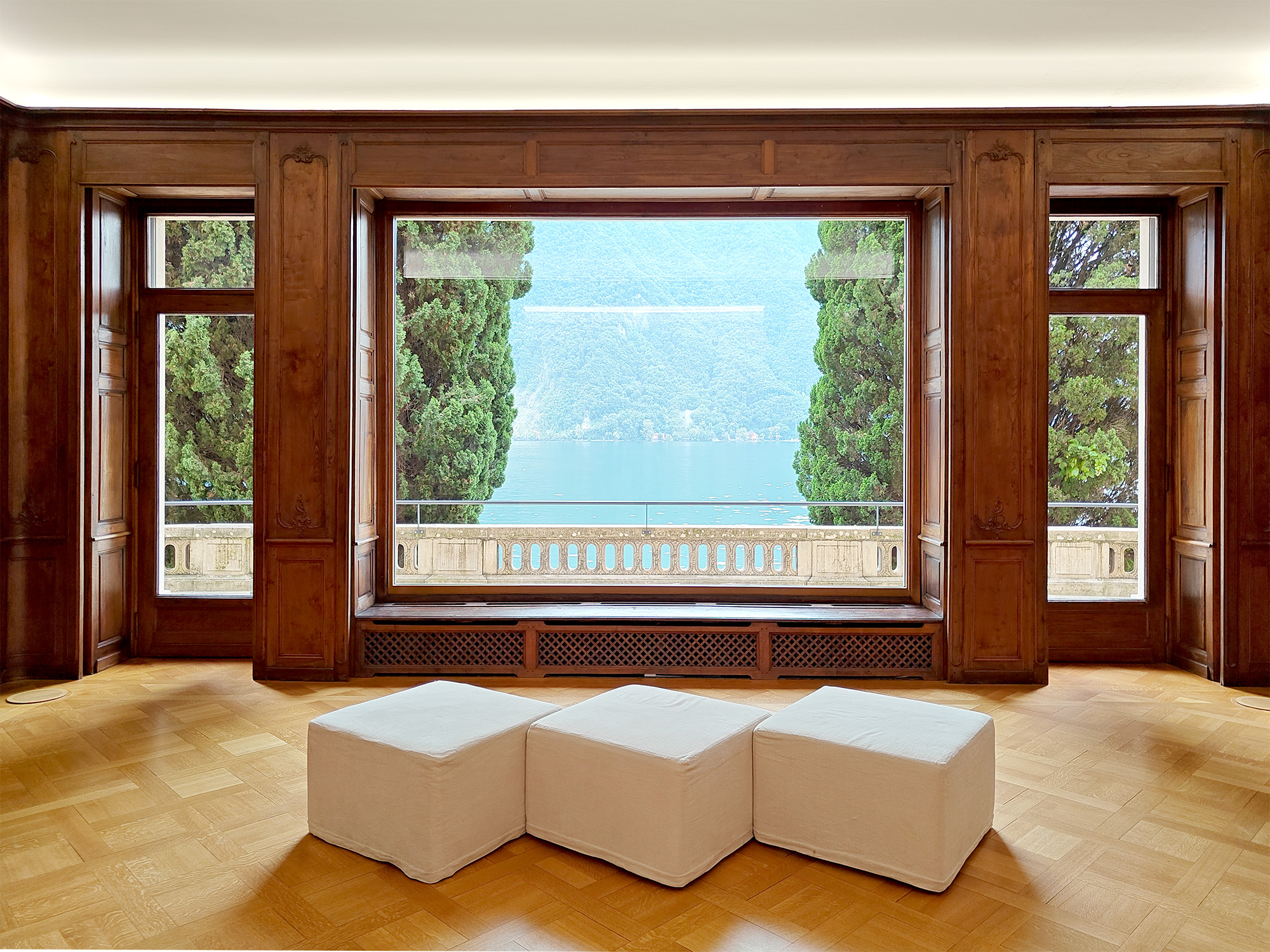
BALLY FOUNDATION
At the start of the Olive Path, at the edge of Lugano, is Villa Heleneum, home to the Bally Foundation. A 1930s villa designed by architect Hugo Dunkel for Hélène Bieber, a cosmopolitan Parisian dancer who dreamt of creating a rural cultural community, the financial crash then second world war meant the place was rarely occupied. However, over its life it remained close to the arts and sciences as a place of musical performance and learning, before beng taken over by Bally, the Swiss luxury fashion house, as the home to their cultural charitable arm.
The current exhibition, Arcadia, speaks to the bucolic setting that surrounds the villa. Taking its cues from the exotic palms and planting clinging to the steep site, surrounding the neoclassical building, the curation thinks about the local Ticino territory with its various relationships to nature, landscape, and migratory and cultural connections that such places support.
At the start of the Olive Path, at the edge of Lugano, is Villa Heleneum, home to the Bally Foundation. A 1930s villa designed by architect Hugo Dunkel for Hélène Bieber, a cosmopolitan Parisian dancer who dreamt of creating a rural cultural community, the financial crash then second world war meant the place was rarely occupied. However, over its life it remained close to the arts and sciences as a place of musical performance and learning, before beng taken over by Bally, the Swiss luxury fashion house, as the home to their cultural charitable arm.
The current exhibition, Arcadia, speaks to the bucolic setting that surrounds the villa. Taking its cues from the exotic palms and planting clinging to the steep site, surrounding the neoclassical building, the curation thinks about the local Ticino territory with its various relationships to nature, landscape, and migratory and cultural connections that such places support.
Arcadia crams in a wide variety of work into the
three floors of the villa, connecting well to the immediate and distant views through
windows in all directions. Recently, at the Biennale Gherdëina, we wrote of a
fantastical wooden sculpture from Julius von Bismarck (00218), and another of
the German artist’s work is on show here – a pair of wafer-thin palms flattened
onto cut aluminium panels, offering ideas of the construct of nature and
man-made representation and dislocation.
Julia Steiner’s wall paintings seem to grow over the architectural mouldings as if nature is growing into the building, and Vanessa Beecroft wood and ceramic heads gaze across the room longingly, perhaps as a callback to Hélène Bieber’s history with the place.
Artist duo Ittah Yoda created a new installation following a residency period, their fantastical landscape of painting, wax sculpture, and watery installation speaking directly to the views through adjacent impressive picture windows. Outside, having left the exhibition, the works spill into the landscape itself – Raphaël Emine’s glazed stoneware organic sculptures hang from a tree, created through craft and 3D modelling, inspired by the writings of Tim Ingold and Gilles Clément.
Julia Steiner’s wall paintings seem to grow over the architectural mouldings as if nature is growing into the building, and Vanessa Beecroft wood and ceramic heads gaze across the room longingly, perhaps as a callback to Hélène Bieber’s history with the place.
Artist duo Ittah Yoda created a new installation following a residency period, their fantastical landscape of painting, wax sculpture, and watery installation speaking directly to the views through adjacent impressive picture windows. Outside, having left the exhibition, the works spill into the landscape itself – Raphaël Emine’s glazed stoneware organic sculptures hang from a tree, created through craft and 3D modelling, inspired by the writings of Tim Ingold and Gilles Clément.







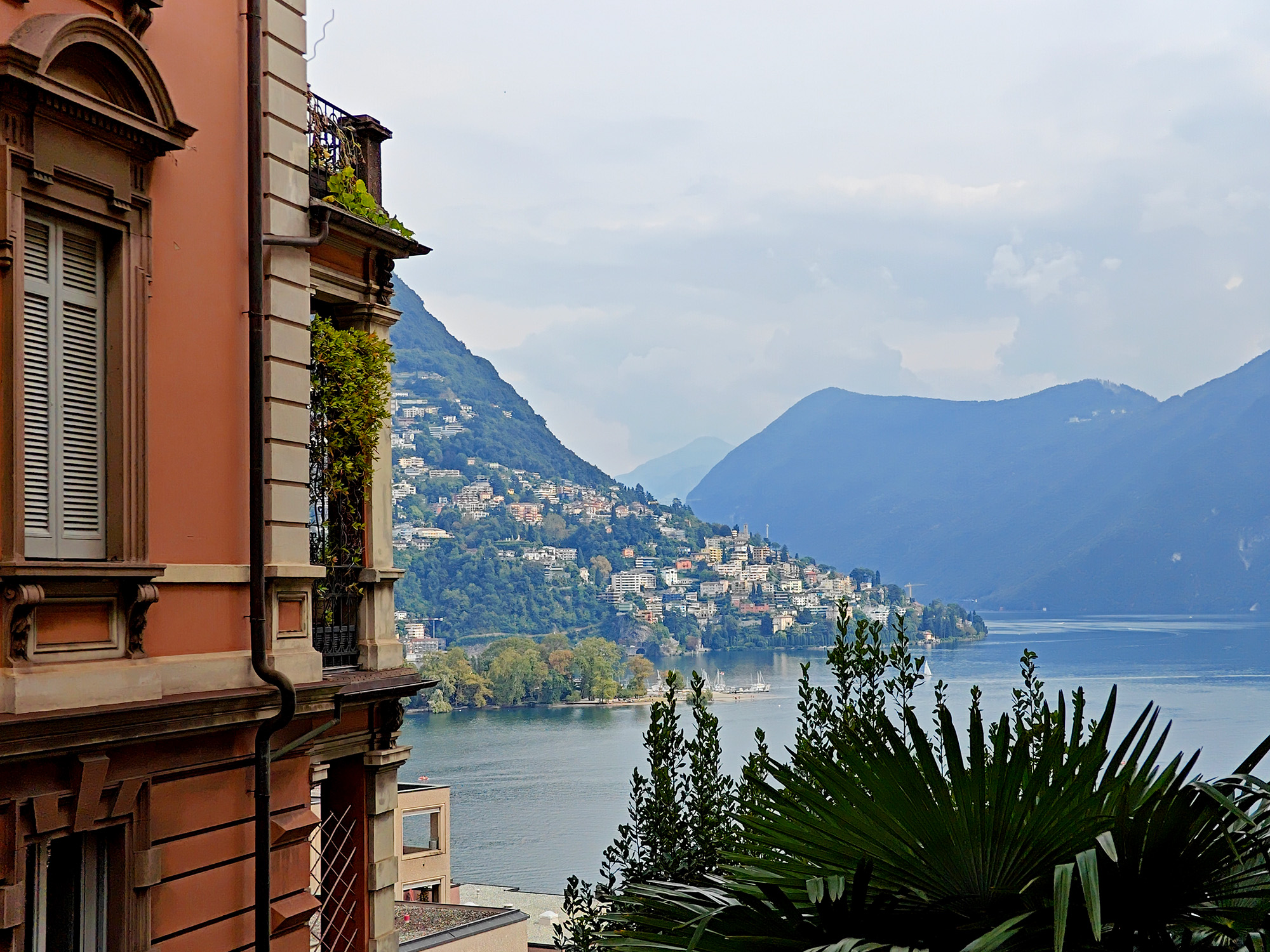









THE ARCHITECTURE OF LUGANO
The town of Lugano is worth a wander. Small enough to explore on foot, with height variation to test the calves and an interesting diversity of neoclassical architecture with interruptions of formal Swiss modernism and plenty of playful masses from the Ticino architecture movement. The Swiss adoration of luxury sadly seeps into the city spaces, however, with every single public plaza and open urban space relentlessly turned into plein air car showrooms, turning what should be open and public space into a mass of car-parking – albeit supercar-parking.
There are a number of Mario Botta buildings in the town: the geometric celebration that is 1985’s Palazzo Ransila; the rotunda of the Centre Cinque Continenti; the megastructure that is the former Banca del Gottardo; and a recently-completed Residenza Cittadella apartment block that heavily references the architect’s older works.
The city’s bus station is also by Botta, is one of the architect’s most civic projects. The simple and logical infrastructure is made of translucent polycarbonate, sitting lightly in the city during the daytime and glowing into the night.
The town of Lugano is worth a wander. Small enough to explore on foot, with height variation to test the calves and an interesting diversity of neoclassical architecture with interruptions of formal Swiss modernism and plenty of playful masses from the Ticino architecture movement. The Swiss adoration of luxury sadly seeps into the city spaces, however, with every single public plaza and open urban space relentlessly turned into plein air car showrooms, turning what should be open and public space into a mass of car-parking – albeit supercar-parking.
There are a number of Mario Botta buildings in the town: the geometric celebration that is 1985’s Palazzo Ransila; the rotunda of the Centre Cinque Continenti; the megastructure that is the former Banca del Gottardo; and a recently-completed Residenza Cittadella apartment block that heavily references the architect’s older works.
The city’s bus station is also by Botta, is one of the architect’s most civic projects. The simple and logical infrastructure is made of translucent polycarbonate, sitting lightly in the city during the daytime and glowing into the night.
ALEXANDER CALDER AT MASI LUGANO
Back at MASI Lugano, a recent exhibition celebrated the work of Alexander Calder. Perhaps most well-known for his gentle hanging mobiles, carefully balanced in form, colour, and engineering – the large galleries of MASI allowed for several of his larger floor-based sculptures to also take centre stage.
The exhibition, Sculpting Time, celebrates the 4th dimension in relation to Calder’s works, be that the mobiles slowly gyrating with the airflow as people walk by, or the changing legibility of his static works as materials reveal and occlude whilst the visitor walks past.
The works are preented across one large open space, the minimal sculptures presenting in a far more maximal way when filling the space altogether. Works on the wall cross sightlines with floor sculptures, while mobiles hang low, so visually all the works seem to overlap, intersect, and create a cacophony of form.
Back at MASI Lugano, a recent exhibition celebrated the work of Alexander Calder. Perhaps most well-known for his gentle hanging mobiles, carefully balanced in form, colour, and engineering – the large galleries of MASI allowed for several of his larger floor-based sculptures to also take centre stage.
The exhibition, Sculpting Time, celebrates the 4th dimension in relation to Calder’s works, be that the mobiles slowly gyrating with the airflow as people walk by, or the changing legibility of his static works as materials reveal and occlude whilst the visitor walks past.
The works are preented across one large open space, the minimal sculptures presenting in a far more maximal way when filling the space altogether. Works on the wall cross sightlines with floor sculptures, while mobiles hang low, so visually all the works seem to overlap, intersect, and create a cacophony of form.







Born in 1898 in Pennsylvania, Alexander Calder had artistry
in the family. Both his father and Scottish Grandfather created public sculpture,
while his mother was a portrait artist who had studied at the Sorbonne. His parents,
however, attempted to dissuade the young Calder from becoming an artist,
convincing him instead to study mechanical engineering in New Jersey.
After a series of engineering jobs, however, Calder moved towards his true calling as an artist, though he never left behind the passion for material and industrial processes. His invention of wire sculptures, a process he termed “drawing in space”, from the 1920s fed into deeper engagement with abstract art. Kinetic motor-fed sculptures followed, and then the development of the hanging mobiles, works through which he explored the materiality of wire, wood, and metal with an engineering understanding.
After World War II he further explored the cutting of sheet metal, another connection to his formal training with materials and construction. Many of these works were on display at MASI, and while the gallery doesn’t quite allow enough space to present Calder’s monumental urban works, some of the sculptures on show clearly illustrate the artist’s interest the potential of scale.
After a series of engineering jobs, however, Calder moved towards his true calling as an artist, though he never left behind the passion for material and industrial processes. His invention of wire sculptures, a process he termed “drawing in space”, from the 1920s fed into deeper engagement with abstract art. Kinetic motor-fed sculptures followed, and then the development of the hanging mobiles, works through which he explored the materiality of wire, wood, and metal with an engineering understanding.
After World War II he further explored the cutting of sheet metal, another connection to his formal training with materials and construction. Many of these works were on display at MASI, and while the gallery doesn’t quite allow enough space to present Calder’s monumental urban works, some of the sculptures on show clearly illustrate the artist’s interest the potential of scale.
MASI LUGANO’S OTHER EXHIBITIONS
MASI Lugano is not a small operation. There are two further distinct presentations in the city asides from the two large gallery spaces at their home building. In a subterranean building nearby, MASI presents exhibitions from the Collezione Giancarlo e Danna Olgiati, the current offer a playful comparison between the artists Yves Klein and Arman in a concept from Mario Botta. Both born in Nice in 1928, and this presentation splits the gallery spaces in half, with a rough chronological presentation facing Klein’s works off against Arman’s within each divided space.
While different in form and colour, there is a conjoining poetic conversation between the two. Klein’s single colour works – not just blue, but covering a whole range of tones – relate to Arman’s Accumulations, perspex frames filled with similar objects to create a post-consumerist assemblage.
The town central Palazzo Reali was once the main home to MASI before the opening of Ivano Gianola’s grand civic building. Now it is home to the historic collection with thematic curations of work from the 15th century to the present day. It’s an altogether slower artistic exploration than the other three exhibitions, suitably spaced out within the decorated rooms of complex of historic buildings, fully renovated in 2019.
MASI Lugano is not a small operation. There are two further distinct presentations in the city asides from the two large gallery spaces at their home building. In a subterranean building nearby, MASI presents exhibitions from the Collezione Giancarlo e Danna Olgiati, the current offer a playful comparison between the artists Yves Klein and Arman in a concept from Mario Botta. Both born in Nice in 1928, and this presentation splits the gallery spaces in half, with a rough chronological presentation facing Klein’s works off against Arman’s within each divided space.
While different in form and colour, there is a conjoining poetic conversation between the two. Klein’s single colour works – not just blue, but covering a whole range of tones – relate to Arman’s Accumulations, perspex frames filled with similar objects to create a post-consumerist assemblage.
The town central Palazzo Reali was once the main home to MASI before the opening of Ivano Gianola’s grand civic building. Now it is home to the historic collection with thematic curations of work from the 15th century to the present day. It’s an altogether slower artistic exploration than the other three exhibitions, suitably spaced out within the decorated rooms of complex of historic buildings, fully renovated in 2019.

















LEAVING LUGANO
Easy to reach from central Switzerland or northern Italy, Lugano offers fresh air, vast views, and refreshing culture. MASI Lugano is central to the busy creative side of the city, with forthcoming exhibitions on Louisa Gagliardi, Eugenio Schmidhauser, Ferdinand Hodler Filippo Franzoni, Richard Paul Lohse planned alongside group exhibitions considering regional landscapes.
The Luigi Ghirri exhibition, in particular, lingers outside of the gallery. The visual way of reading place, landscape, and people is hard to shake off once so joyfully presented across MASI’s busy exhibition and infuses every way of looking at Lugano and the lake after leaving. And then after leaving Lugano, those experiences of the city, architecture & lake continue to linger.
Easy to reach from central Switzerland or northern Italy, Lugano offers fresh air, vast views, and refreshing culture. MASI Lugano is central to the busy creative side of the city, with forthcoming exhibitions on Louisa Gagliardi, Eugenio Schmidhauser, Ferdinand Hodler Filippo Franzoni, Richard Paul Lohse planned alongside group exhibitions considering regional landscapes.
The Luigi Ghirri exhibition, in particular, lingers outside of the gallery. The visual way of reading place, landscape, and people is hard to shake off once so joyfully presented across MASI’s busy exhibition and infuses every way of looking at Lugano and the lake after leaving. And then after leaving Lugano, those experiences of the city, architecture & lake continue to linger.
MASI Lugano (Museo d’arte della Svizzera italiana) was established in 2015, when two long-standing Lugano museums - the Museo Cantonale d’Arte and Museo d’Arte della Città di Lugano – merged. Thanks to its strategic position, at this cultural crossroads between the north and south of the Alps, MASI Lugano has quickly become one of the most popular art museums in Switzerland. In its two venues – the modern LAC cultural centre and the historical Palazzo Reali – MASI presents a rich programme of temporary shows and frequently changing exhibitions devoted to the works in its collection. It offers a wide range of mediation activities in several languages, upholding the values of inclusion and accessibility. MASI is committed to providing a participatory, engaging museum experience for all. Its artistic scope is expanded by its partnership with the Giancarlo and Danna Olgiati Collection - part of the MASI circuit – which is entirely dedicated to modern and contemporary art.
www.masilugano.ch/en
visit
Luigi Ghirri. Viaggi. Photographs 1970-1991 is on at
MASI Lugano until 26 January 2025. Full details available at: www.masilugano.ch/en/masi/in-corso/agenda/events/evento~mostre~2024~lac~luigi-ghirri~.html
Yves Klein e Arman. Le Vide et Le Plein is on view at
the Collezione Giancarlo e Danna Olgiati until 12 January 2025. Full details
available at: www.masilugano.ch/en/masi/in-corso/agenda/events/evento~mostre~2024~collezione-olgiati~le-vide-et-le-plein~.html
The collection of MASI Lugano is on view at Palazzo Reali.
Full details available at: www.masilugano.ch/en/masi/in-corso/agenda/events/evento~mostre~2023~palazzo-reali~la-collezione~.html
Arcadia is on view at the Bally Foundation until 12
January 2025. Full details available at: www.ballyfoundation.ch/en/arcadia
images
All photographs © Will Jennings.
Except Luigi Ghirri photogaphs:
Luigi Ghirri, Rimini (1977). Lambda print, new print
(2022). Eredi du Luigi Ghirri. Courtesy & © Eredi di Luigi Ghirri.
Luigi Ghirri, Capri (1981). Lambda print, new print
(2022). Eredi du Luigi Ghirri. Courtesy & © Eredi di Luigi Ghirri.
Luigi Ghirri, Scandiano, presso la Rocca di Boiardo (1985).
Lambda print, new print (2022). Eredi du Luigi Ghirri. Courtesy & © Eredi di
Luigi Ghirri.
Luigi Ghirri, Alpe do Suisi (1979). Lambda print, new
print (2022). Eredi du Luigi Ghirri. Courtesy & © Eredi di Luigi Ghirri.
Luigi Ghirri, Arles (1979). Lambda print, new print
(2022). Eredi du Luigi Ghirri. Courtesy & © Eredi di Luigi Ghirri.
publication date
18 December 2024
tags
Alps, Arman, Bally, Bally Foundation, Vanessa Beecroft, Hélène Bieber, Mario Botta, Jean Baudrillard, Alexander Calder, Campione d’Italia, Collezione Giancarlo e Danna Olgiati, Hugo Dunkel, Raphaël Emine, Gandria, Luigi Ghirri, Ittah Yoda, Ivano Gioanola, Thomas Huber, Will Jennings, Yves Klein, Lake, Lake Lugano, Landscape, Light, James Lingwood, Lugano, Map, MASI Lugano, Mountains, Palazzo Reali, Photography, Sculpture, Julia Steiner, Switzerland, Ticino architecture, Tourism, Villa Heleneum, Julius von Bismarck
Yves Klein e Arman. Le Vide et Le Plein is on view at the Collezione Giancarlo e Danna Olgiati until 12 January 2025. Full details available at: www.masilugano.ch/en/masi/in-corso/agenda/events/evento~mostre~2024~collezione-olgiati~le-vide-et-le-plein~.html
The collection of MASI Lugano is on view at Palazzo Reali. Full details available at: www.masilugano.ch/en/masi/in-corso/agenda/events/evento~mostre~2023~palazzo-reali~la-collezione~.html
Arcadia is on view at the Bally Foundation until 12 January 2025. Full details available at: www.ballyfoundation.ch/en/arcadia


